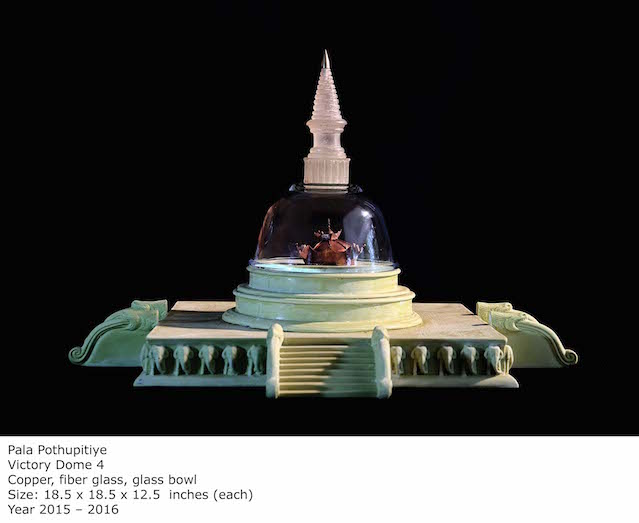Artists Of South Asia Tell A Tale Of Two Cities

By Dev N Pathak –May 3, 2017
The art project A Tale of Two Cities is scheduled to reach Colombo, Sri Lanka, in August this year for an exhibition at Red Dot Gallery of Theertha Artists’ Collective. Based on it’s recently concluded show at Indira Gandhi National Center for Arts in New Delhi in March 2017 the following rumination could be an anchor for the Sinhala audience.
The artists in South Asia are beginning to make concerted effort toward creating a discourse, that can become stimulant for scholars of cultural politics in the region. An effort of similar kind is an art project titled A Tale of Two Cities began in 2015. The project brought together artists from Sri Lanka and India to revisit two cities of profound civilizational significance, Anuradhapura and Varanasi. These cities belong to folklore, history, and memory immaculately coloured with religiosity. But then, they are not frozen in time and space, and hence they have acquired novel facets in the scheme of contemporary. The art project hinged on the insightful conceptualization of Renu Modi (Director, Gallery Espace, Delhi) resulting into over a yearlong collaboration of Serendipity Art Trust (Delhi), Theertha Artists’ Collective (Colombo) and Gallery Espace (Delhi). In the kernel of the concept was the idea of ‘sacred geographies’, an intellectual stimulus for the artists to explore the two cities in this research-based art-making process. A collaborative project of this nature is indeed a befitting response in the wake of cultural globalization. It yields a possibility to re-imagine artists’ South Asia, entailing border crossing, nuanced networking, and empathy for the socio-cultural and political contexts across the modern cartographies. The artists and groups ought to be commended on this front of engendering artists’ regionalism, a nebulous institutional arrangement for more creative version of solidarity in the wake of endangered international relations of nation-states. The aesthetic consequence of the project is exhibition of artworks, first held at Serendipity Arts Festival in Goa in December 2016, second at Indira Gandhi National Center for Arts in New Delhi in March 2017, and third is scheduled in August this year at Red Dot Gallery in Colombo. The exhibition makes an emphatic statement for an art-lover, critique, historian and anthropologists of art: shared sacred is more important than security threats in the region of South Asia!

Image courtesy: Gallery Espace, New Delhi
Nature of Shared Sacred
The exhibition persuades that the idea of sacred is not enshrined in the religious canons alone. The artists’ tale of two cities brings about a fusion of personal subjectivities and impersonal sacred emblems. Thus, the notion of sacred arising from the exhibition connects histories, biographies, and philosophy in the larger anthropological framework. Anoli Perera’s work titled Geographies of Deliverance dwells upon the famous twentieth century Sinhala song Dano Buddhunge (Those who know Buddha’s Dharma), in order to narrate what she calls ‘mental mappings of the pilgrims’. Anoli underlines an emotionally rooted and experiential sacred in her artworks. It amounts to enabling the artists to narrate- what they saw, what they believed in, and what shook their belief. Pala Pothupitiye, another critically acclaimed artist from Sri Lanka, goes to the extent of suggesting that ‘history of Sinhala Buddhism has been history of violence’. And thus his installation, Victory Dome, performs a meaningful heresy of doubting the presence of any sacred relic whatsoever in the aggressively protected Buddhist domes in Sri Lanka. Gazing at Bandu Manamperi’s Moonstone and Charcoal, one begins to believe that belief in sacred is as vulnerable as the materiality of the signifiers. For anyone versed in the language of semiotics the ensemble assumes poignant promises.

Image courtesy: Gallery Espace, New Delhi

